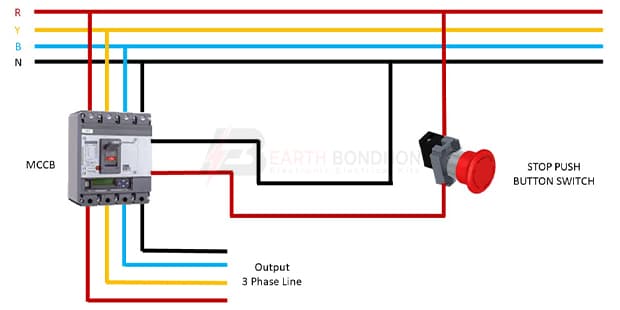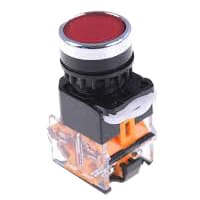Shunt Trip breaker wiring diagram:
This Diagram shows the Shunt Trip breaker wiring diagram. In this circuit, we use FP MCCB ( Four Pole Molded Case Circuit Breaker ), and a stop push button. This circuit diagram is very simple and easy to make. If you want to know more details about this circuit please check our youtube video below the post. Please stay with our website for more updates about electrical electronics and robotics projects gadgets and circuits.
Advertisements
Components needed For this Project:
You can get the components from any of the sites below:
*Please note: These are affiliate links. I may make a commission if you buy the components through these links. I would appreciate your support in this way!
Advertisements
Components used to make the Shunt Trip breaker wiring diagram:
The MCCB consists of a bimetallic sheet that expands and contracts when the temperature of the MCCB changes. Due to overload, the bimetallic strip will start to bend and eventually. it will trip if more current flows in the circuit than the predetermined current. The trip mechanism opens the breaker. MCCB stands for Molded Case Circuit Breaker. It is another type of electrical protection device that is used when the load current exceeds the limit of a miniature circuit breaker. The MCCB provides Protection against Overload, and Short Circuit Faults and is also used for Switching the Circuits.
02. Stop Switch:
An NC (Normally Closed) Push Button is a Push Button That, In Its Default State, Makes Electrical Contact With The Circuit. An NC (Normally Closed) Push Button is a Push Button that, in its Default State, Makes electrical Contact With the Circuit. When The Button Is Pressed Down, The Switch no Longer Makes Electrical Contact And The Circuit is Now Open. When The Button is Not Pressed, Electricity Can Flow, But When it is Pressed The Circuit is Broken. This type Of Switch is Also known As a Normally Closed (NC) Switch.
Thank You for visiting the website. Keep visiting for more Updates.
Frequently asked questions
So, to summarize, a shunt trip is a device that allows you to remotely and quickly turn off a circuit diagram breaker when necessary, particularly in situations where safety or speed is critical diagram such as during a fire or when you want to isolate a specific area of your electrical system without physically going to the breaker.
MCCB(Molded Case Circuit Breaker) is widely used in power supply distribution systems for protecting an electrical circuit from damage caused by overload or short circuits. The shunt release device, an internal accessory of the MCCB, opens the mechanism in response to an externally applied voltage signal.
There are three basic circuit diagram breaker varieties: standard breakers (which include both single-pole and double-pole circuit diagram breakers), ground fault circuit interrupter circuit diagram breakers (GFCIs), and arc fault circuit diagram interrupter circuit breakers (AFCIs).
A Shunt Trip configuration is a 3-terminal device similar to the Series Trip but with the addition of a third terminal between the contacts and the coil. This circuit diagram is usually used to control 2 separate loads (A& B) from the same power supply source while sensing overload current in only one load (B).
The main difference between a shunt trip and an under-voltage release was that the shunt trip opens the circuit diagram breaker when a control voltage is applied to its coil. On the other hand, the undervoltage release trips the breaker when a control voltage is removed from it is a coil.
Read more Single Phase Wiring
What is a kilowatt-hour (kWh) | kwh formula | What does kwh mean
Introduction to Electrical Units and CircuitskW and kWh on your electricity bill As your home uses electricity during...
What is the Difference Between kVA | What does KVA mean | kVA formula
Difference Between KVA ExplainedWhat does KVA Mean? There are technical terms aplenty when it comes to generators, and...
Power Factor | Power Unit | Energy | Electricity Unit
Power factor definition | Calculating Power FactorPower Factor Values In a purely resistive circuit, the power factor...



0 Comments